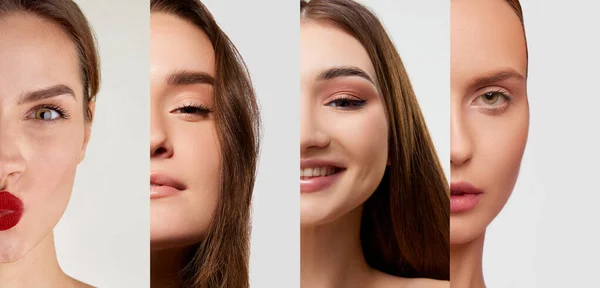Discover how to know your skin type female with our comprehensive guide. Learn the essential tips and techniques to identify your unique skin type and tailor your skincare regimen accordingly.
In the vast world of skincare, understanding your skin type is the cornerstone to crafting a regimen that truly works wonders. Like a fingerprint, each woman’s skin possesses its own unique traits, demands, and quirks.
Embarking on the journey to decipher your skin’s language is akin to unlocking a personal beauty code, revealing the secrets to radiant, healthy looking skin.
From the dewy embrace of combination skin to the resilient fortitude of oily skin, and the delicate balance of sensitive skin, knowing your skin type is akin to wielding a powerful tool in the pursuit of skincare mastery. So, let’s delve into the captivating realm of skin classification, empowering every woman to embrace her individuality and unleash the glow within.

Table of Contents
ToggleHow To Know Your Skin Type Female
Understanding your skin type is crucial for a healthy skincare routine. By assessing characteristics like oiliness, dryness, and sensitivity, you can determine whether your skin is normal, dry, oily, combination, or sensitive.
Assessing Your Skin Type
To identify your skin type, start by cleansing your face thoroughly with a gentle cleanser. After patting your skin dry, observe its natural state without applying any products. Pay attention to factors such as oiliness, dryness, and any areas of sensitivity or irritation.
Different Skin Types Explained
Normal Skin
Balanced and clear, with minimal imperfections.
Dry Skin
Often feels tight or flaky, especially after cleansing.
Oily Skin
Prone to shine and may experience frequent breakouts.
Combination Skin
Exhibits characteristics of both oily and dry skin, with different areas of the face presenting different concerns.
Sensitive Skin
Easily irritated by certain products or environmental factors, leading to redness or discomfort.
Tailoring Your Skincare Routine
Once you’ve identified your skin type, tailor your skincare routine accordingly. Choose products formulated to address your specific concerns, whether it’s hydrating dry skin, controlling oil production, or soothing sensitivity.
Understanding the Different Skin Types
Normal Skin
Characteristics
Balanced moisture, even tone, minimal imperfections.
How to Identify
Smooth texture, no visible pores or blemishes.
Common Challenges and Concerns
Occasional dryness or oiliness, sensitivity to harsh products.
Dry Skin
Characteristics
Tightness, flakiness, dull appearance.
How to Identify
Rough patches, visible flakes, discomfort.
Common Challenges and Concerns
Prone to irritation, fine lines, rough texture.
Factors Contributing to Dry Skin
Environmental factors, genetics, harsh skincare products.
Oily Skin
Characteristics
Excess sebum production, enlarged pores, shiny complexion.
How to Identify
Persistent shine, greasy texture, frequent breakouts.
Common Challenges and Concerns
Acne, blackheads, uneven complexion.
Factors Contributing to Oily Skin
Hormonal changes, genetics, humid climates.
Combination Skin
Characteristics
Mix of dry and oily areas, often with an oily T-zone.
How to Identify
Oily forehead, nose, and chin; dry cheeks.
Common Challenges and Concerns
Striking a balance between hydration and oil control, prone to acne in oily areas.
Factors Contributing to Combination Skin
Genetics, hormonal fluctuations, improper skincare routines.
Sensitive Skin
Characteristics
Reactivity to products, redness, itching, burning.
How to Identify
Easily irritated by skincare or environmental factors.
Common Challenges and Concerns
Allergic reactions, inflammation, discomfort.
Factors Contributing to Sensitive Skin
Genetic predisposition, environmental factors, harsh ingredients.
By addressing the unique characteristics and concerns of each skin type, individuals can tailor their skincare routines effectively, promoting healthier and more radiant skin.

Methods to Determine Your Skin Type
Visual Inspection
Observing Skin Texture
Examine the surface of your skin for smoothness or roughness.
Evaluating Pore Size
Notice the size of pores, whether they appear enlarged or minimized.
Identifying Presence of Shine or Dry Patches
Look for areas with excessive shine or flakiness indicating dryness.
Noting Sensitivity and Reactivity
Pay attention to any redness, irritation, or reactions to certain products.
The Blotting Paper Test
Procedure
Press blotting paper onto different areas of your face to absorb excess oil.
Interpretation of Results
Assess the amount of oil absorbed to determine skin type—oily, dry, combination, or normal.
The Bare-Faced Test
Instructions
Wash your face thoroughly and refrain from applying any products.
Observations to Make
Notice how your skin feels and looks throughout the day, including any changes in oiliness or dryness.
Recording Reactions and Sensations
Document any discomfort, sensitivity, or reactions experienced during the test.
Seeking Professional Guidance
Consulting Dermatologists or Estheticians
Schedule appointments with skincare experts for personalized assessments.
Skin Analysis Tools and Techniques
Utilize specialized tools and techniques such as moisture meters or skin scanners for in-depth analysis.
These methods provide valuable insights into your skin type, guiding you towards tailored skincare routines and product selections.

Tailoring Skincare Routine to Your Skin Type
Cleansing
Suitable Cleansers for Different Skin Types
Normal Skin
Opt for gentle foaming or cream cleansers.
Oily Skin
Look for gel-based or foaming cleansers with salicylic acid.
Dry Skin
Choose cream or oil-based cleansers that hydrate while cleansing.
Sensitive Skin
Use fragrance-free, gentle cleansers without harsh chemicals.
Cleansing Techniques
Gentle Massage
Apply cleanser in circular motions to remove dirt and oil effectively.
Avoid Over-cleansing
Cleanse only twice daily to prevent stripping natural oils.
Moisturizing
Choosing the Right Moisturizer
Consider Texture
Select lightweight lotions for oily skin and richer creams for dry skin.
Ingredients
Look for moisturizers with hyaluronic acid for hydration and ceramides for barrier repair.
Moisturizing Techniques
Apply on Damp Skin
Lock in moisture by applying moisturizer after cleansing.
Even Application
Gently massage moisturizer in upward motions for better absorption.
Sun Protection
Importance of Sunscreen
UV Protection
Shields skin from harmful UV rays, preventing sunburn and premature aging.
Skin Cancer Prevention
Reduces the risk of skin cancer caused by UV exposure.
Selecting Sunscreen Based on Skin Type
Broad Spectrum
Choose sunscreen that protects against both UVA and UVB rays.
Non-comedogenic
Opt for oil-free formulas for acne-prone or oily skin.
Additional Skincare Products
Serums, Toners, and Essences
Targeted Treatment
Serums address specific skin concerns like dark spots or wrinkles.
Balancing pH
Toners and essences help restore skin’s pH balance after cleansing.
Exfoliants and Masks
Gentle Exfoliation
Use chemical exfoliants containing AHAs or BHAs for smoother skin.
Deep Cleansing
Masks unclog pores and provide intensive treatment for various skin issues.
Lifestyle Factors Affecting Skin Health
Diet and Hydration
What you eat and drink significantly impacts your skin’s health and appearance. Maintaining a balanced diet rich in antioxidants, vitamins, and minerals promotes radiant skin. Adequate hydration ensures proper moisture levels, keeping skin supple and youthful.
Stress Management
Chronic stress can wreak havoc on your skin, leading to inflammation, breakouts, and premature aging. Practicing stress-relieving activities such as meditation, yoga, or deep breathing can help maintain skin health and vitality.
Sleep Patterns
Quality sleep is essential for skin repair and regeneration. Lack of sleep can result in dullness, dark circles, and fine lines. Establishing a consistent sleep schedule and creating a relaxing bedtime routine can improve overall skin health.
Environmental Factors
External elements like UV radiation, pollution, and harsh weather conditions can damage the skin’s barrier function and accelerate aging. Protecting your skin with sunscreen, wearing protective clothing, and using skincare products with antioxidants can shield against environmental stressors and maintain skin integrity.
Common Mistakes to Avoid
In the pursuit of flawless skin, it’s crucial to steer clear of common mistakes that can hinder your skincare journey. Over exfoliation, a common blunder, can strip your skin’s natural oils and lead to irritation. Choosing products unsuitable for your skin type may exacerbate issues rather than resolve them.
Ignoring signs of sensitivity or irritation can worsen skin conditions over time. Consistency is key; an inconsistent skincare routine can impede progress and prevent desired results. By avoiding these pitfalls, you pave the way for healthier, radiant skin.

FAQs
What are the different skin types females can have?
Female individuals can have various skin types, including oily, dry, combination, normal, and sensitive skin. Each type comes with its own set of characteristics and requires specific care routines.
How can I determine my skin type?
You can determine your skin type by observing its characteristics. Oily skin tends to be shiny and prone to acne, dry skin feels tight and may have flaky patches, combination skin has both oily and dry areas, normal skin is balanced with no excessive oil or dryness, and sensitive skin is easily irritated by various products.
What are the common signs of oily skin in females?
Signs of oily skin in females include a shiny complexion, enlarged pores, frequent breakouts, and a tendency for makeup to slide off easily.
What are the indicators of dry skin in females?
Dry skin in females may show signs such as tightness, flakiness, rough texture, dull appearance, and discomfort, especially after washing.
How do I recognize combination skin in females?
Combination skin typically presents with an oily T-zone (forehead, nose, and chin) while the cheeks remain dry or normal. This skin type often experiences both acne and dryness.
What defines normal skin in females?
Normal skin in females is characterized by a balanced complexion with minimal blemishes, even texture, and no excessive oiliness or dryness. It appears healthy and radiant.
How can I tell if I have sensitive skin as a female?
Sensitive skin in females tends to react easily to skincare products or environmental factors, leading to redness, itching, burning, or tightness. It may also be prone to allergic reactions.
Why is it important to know my skin type as a female?
Understanding your skin type helps you select appropriate skincare products and routines tailored to your specific needs, leading to better results and healthier skin in the long run.
Can my skin type change over time as a female?
Yes, hormonal changes, aging, climate, lifestyle factors, and skincare habits can influence your skin type. It’s essential to periodically reassess your skin’s needs and adjust your routine accordingly.
What should I do if I’m unsure about my skin type as a female?
If you’re uncertain about your skin type, consider consulting a dermatologist or skincare professional who can assess your skin and provide personalized recommendations based on your concerns and observations.
Conclusion
In conclusion, understanding one’s skin type is essential for maintaining healthy and radiant skin. By identifying whether you have dry, oily, combination, or sensitive skin, you can tailor your skincare routine to meet your specific needs.
Regularly assessing your skin’s characteristics and adapting your regimen accordingly will not only enhance its overall health but also promote a confident and radiant complexion. Remember, skincare is not one-size-fits-all, and embracing your unique skin type is the first step towards achieving a glowing and vibrant complexion for years to come.

